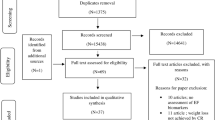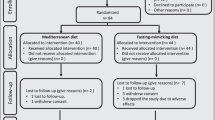Abstract
Background/Objectives:
Endothelial dysfunction, which can be manifested by loss of nitric oxide bioavailability, is an increasingly recognized cause of cardiovascular diseases. Previous studies showed that diets affect endothelial function and modify cardiovascular risks. This study aimed to assess the effects of Ramadan fasting, as a diet intervention, on endothelial function.
Subjects/Methods:
The study population consisted of 21 male patients (mean age: 52±9 years) with cardiovascular risks (coronary artery disease, cerebrovascular or peripheral arterial diseases). The biochemical variables in serum of patients were measured 2 days before and after Ramadan fasting. The levels of asymmetric dimethylarginine (ADMA) and vascular endothelial growth factor (VEGF) were evaluated using the enzyme-linked immunosorbent assay. Nitric oxide (NO) and Malondialdehyde (MDA) levels were measured by the Griess and thiobarbituric acid reaction substances assay, respectively.
Results:
NO levels in patients after Ramadan fasting were significantly higher compared with the baseline value (85.1±11.54 vs 75.8±10.7 μmol/l) (P<0.05). Post-Ramadan levels of ADMA decreased significantly in comparison with pre-Ramadan levels (802.6±60.9 vs 837.6±51.0 nmol/l) (P<0.05). In addition, the levels of VEGF and MDA changed during Ramadan fasting, but these changes were not statistically significant (228.1±27.1 vs 222.7±22.9 pg/ml and 3.2±0.7 vs 3.6±1.1 μmol/l, respectively).
Conclusions:
Ramadan fasting may have beneficial effects on endothelial function and can modulate cardiovascular risks. Further studies are needed to confirm the clinical significance of Ramadan fasting on cardiovascular health.
This is a preview of subscription content, access via your institution
Access options
Subscribe to this journal
Receive 12 print issues and online access
$259.00 per year
only $21.58 per issue
Buy this article
- Purchase on Springer Link
- Instant access to full article PDF
Prices may be subject to local taxes which are calculated during checkout

Similar content being viewed by others
References
Leiper J, Molla A . Effects on health of fluid restriction during fasting in Ramadan. Eur J Clin Nutr 2003; 57: S30–S38.
Al Suwaidi J, Bener A, Hajar H, Numan M . Does hospitalization for congestive heart failure occur more frequently in Ramadan: a population-based study (1991–2001). Int J Cardiol 2004; 96: 217–221.
Sarraf-Zadegan N, Atashi M, Naderi GA, Baghai AM, Asgary S, Fatehifar MR et al. The effect of fasting in Ramadan on the values and interrelations between biochemical, coagulation and hematological factors. Ann Saudi Med 2000; 20: 377–381.
Brown AA, Hu FB . Dietary modulation of endothelial function: implications for cardiovascular disease. Am J Clin Nutr 2001; 73: 673–686.
De Caterina R . Endothelial dysfunctions: common denominators in vascular disease. Curr Opin Lipidol 2000; 11: 9–23.
Heitzer T, Schlinzig T, Krohn K, Meinertz T, Münzel T . Endothelial dysfunction, oxidative stress, and risk of cardiovascular events in patients with coronary artery disease. Circulation 2001; 104: 2673–2678.
Gimbrone MA Jr . Vascular endothelium: an integrator of pathophysiologic stimuli in atherosclerosis. Am J Cardiol 1995; 75: 67B–70B.
Lerman A, Burnett J Jr . Intact and altered endothelium in regulation of vasomotion. Circulation 1992; 86: III12–III19.
Cai H, Harrison DG . Endothelial dysfunction in cardiovascular diseases: the role of oxidant stress. Circ Res 2000; 87: 840–844.
Böger RH . Asymmetric dimethylarginine (ADMA): a novel risk marker in cardiovascular medicine and beyond. Ann Med 2006; 38: 126–136.
Sibal L, Agarwal SC, Home PD, Boger RH . The role of asymmetric dimethylarginine (ADMA) in endothelial dysfunction and cardiovascular disease. Curr Cardiol Rev 2010; 6: 82.
Miyazaki H, Matsuoka H, Cooke JP, Usui M, Ueda S, Okuda S et al. Endogenous nitric oxide synthase inhibitor a novel marker of atherosclerosis. Circulation 1999; 99: 1141–1146.
Fukumura D, Gohongi T, Kadambi A, Izumi Y, Ang J, Yun C-O et al. Predominant role of endothelial nitric oxide synthase in vascular endothelial growth factor-induced angiogenesis and vascular permeability. Proc Natl Acad Sci USA 2001; 98: 2604–2609.
Hood JD, Meininger CJ, Ziche M, Granger HJ . VEGF upregulates ecNOS message, protein, and NO production in human endothelial cells. Am J Physiol Heart Circ Physiol 1998; 274: H1054–H1058.
Murohara T, Horowitz JR, Silver M, Tsurumi Y, Chen D, Sullivan A et al. Vascular endothelial growth factor/vascular permeability factor enhances vascular permeability via nitric oxide and prostacyclin. Circulation 1998; 97: 99–107.
Kadiiska M, Gladen B, Baird D, Germolec D, Graham L, Parker C et al. Biomarkers of Oxidative Stress Study II: Are oxidation products of lipids, proteins, and DNA markers of CCl4 poisoning? Free Radic Biol Med 2005; 38: 698–710.
Badalzadeh R, Mohammadi M, Najafi M, Ahmadiasl N, Farajnia S, Ebrahimi H . The additive effects of ischemic postconditioning and cyclosporine-A on nitric oxide activity and functions of diabetic myocardium injured by ischemia/reperfusion. J Cardiovasc Pharmacol Ther 2012; 17: 181–189.
Nezami N, Ghorbanihaghjo A, Rashtchizadeh N, Argani H, Tafrishinejad A, Ghorashi S et al. Atherogenic changes of low-density lipoprotein susceptibility to oxidation, and antioxidant enzymes in pulmonary tuberculosis. Atherosclerosis 2011; 217: 268–273.
AW N, MI O, MR A . The Influence Of Ramadan Fasting On Cardiovascular Risk Factors. J Endocrinol Metab 2010; 1: 1.
Nematy M, Alinezhad-Namaghi M, Rashed MM, Mozhdehifard M, Sajjadi SS, Akhlaghi S et al. Effects of Ramadan fasting on cardiovascular risk factors: a prospective observational study. Nutr J 2012; 11: 69.
Temizhan A, Dönderici Ö, Ouz D, Demirbas B . Is there any effect of Ramadan fasting on acute coronary heart disease events? Int J Cardiol 1999; 70: 149–153.
Burazeri G, Goda A, Kark JD . Religious observance and acute coronary syndrome in predominantly Muslim Albania: a population-based case-control study in Tirana. Ann Epidemiol 2008; 18: 937–945.
Mohler ER, Sibley AA, Stein R, Davila‐Roman V, Wyatt H, Badellino K et al. Endothelial function and weight loss: Comparison of low‐carbohydrate and low‐fat diets. Obesity 2013; 21: 504–509.
Vanhoutte PM . Endothelial dysfunction: the first step toward coronary arteriosclerosis. Circ J 2009; 73: 595–601.
Förstermann U . Nitric oxide and oxidative stress in vascular disease. Pflugers Arch 2010; 459: 923–939.
Hagopian K, Harper M-E, Ram JJ, Humble SJ, Weindruch R, Ramsey JJ . Long-term calorie restriction reduces proton leak and hydrogen peroxide production in liver mitochondria. Am J Physiol Endocrinol Metab 2005; 288: E674–E684.
Bevilacqua L, Ramsey JJ, Hagopian K, Weindruch R, Harper M-E . Effects of short-and medium-term calorie restriction on muscle mitochondrial proton leak and reactive oxygen species production. Am J Physiol Endocrinol Metab 2004; 286: E852–E861.
Bevilacqua L, Ramsey JJ, Hagopian K, Weindruch R, Harper M-E . Long-term caloric restriction increases UCP3 content but decreases proton leak and reactive oxygen species production in rat skeletal muscle mitochondria. Am J Physiol Endocrinol Metab 2005; 289: E429–E438.
Bastani A, Azadmanesh F, Ghorishi SM, Abdoljabary M, Bahrami Z, Heidari MH . Assessment of Malondialdehyde, 8-iso prostaglandin F2α, 8-hydroxy-2'-deoxyguanosine Factors and Protein Carbonyl Groups as Markers of Oxidative Stress in the Fasting Individuals in Tehran. J Appl Environ Biol Sci 2013; 3: 37–41.
Schulz E, Jansen T, Wenzel P, Daiber A, Münzel T . Nitric oxide, tetrahydrobiopterin, oxidative stress, and endothelial dysfunction in hypertension. Antioxid Redox Signal 2008; 10: 1115–1126.
Smith CL, Birdsey GM, Anthony S, Arrigoni FI, Leiper JM, Vallance P . Dimethylarginine dimethylaminohydrolase activity modulates ADMA levels, VEGF expression, and cell phenotype. Biochem Biophys Res Commun 2003; 308: 984–989.
Päivä H, Lehtimäki T, Laakso J, Ruokonen I, Tervonen R, Metso S et al. Dietary composition as a determinant of plasma asymmetric dimethylarginine in subjects with mild hypercholesterolemia. Metabolism 2004; 53: 1072–1075.
Liu VW, Huang PL . Cardiovascular roles of nitric oxide: A review of insights from nitric oxide synthase gene disrupted mice. Cardiovasc Res 2008; 77: 19–29.
Mügge A, Hanefeld C, Böger RH . Plasma concentration of asymmetric dimethylarginine and the risk of coronary heart disease: rationale and design of the multicenter CARDIAC study. Atheroscler Suppl 2003; 4: 29–32.
Dulak J, Józkowicz A, Dembinska-Kiec A, Guevara I, Zdzienicka A, Zmudzinska-Grochot D et al. Nitric oxide induces the synthesis of vascular endothelial growth factor by rat vascular smooth muscle cells. Arterioscler Thromb Vasc Biol 2000; 20: 659–666.
Soydinç S, Çelik A, Demiryürek S, Davutoğlu V, Tarakçıoğlu M, Aksoy M . The relationship between oxidative stress, nitric oxide, and coronary artery disease. Eur J Gen Med 2007; 4: 62–66.
Tanaga K, Bujo H, Inoue M, Mikami K, Kotani K, Takahashi K et al. Increased circulating malondialdehyde-modified LDL levels in patients with coronary artery diseases and their association with peak sizes of LDL particles. Arterioscler Thromb Vasc Biol 2002; 22: 662–666.
Acknowledgements
We greatly appreciate Dr Amir Ghorbani-Haghjo and Dr Ali Mota for reviewing and critically reading the manuscript. We thank the Students’ Research Committee, Tabriz University of Medical Sciences for financial support.
Author information
Authors and Affiliations
Corresponding author
Ethics declarations
Competing interests
The authors declare no conflict of interest.
Rights and permissions
About this article
Cite this article
Yousefi, B., Faghfoori, Z., Samadi, N. et al. The effects of Ramadan fasting on endothelial function in patients with cardiovascular diseases. Eur J Clin Nutr 68, 835–839 (2014). https://doi.org/10.1038/ejcn.2014.61
Received:
Revised:
Accepted:
Published:
Issue Date:
DOI: https://doi.org/10.1038/ejcn.2014.61
This article is cited by
-
Asymmetric dimethylarginine and Ramadan fasting
European Journal of Clinical Nutrition (2014)



